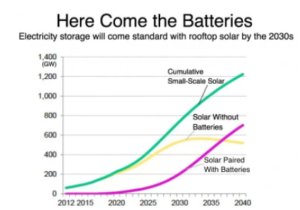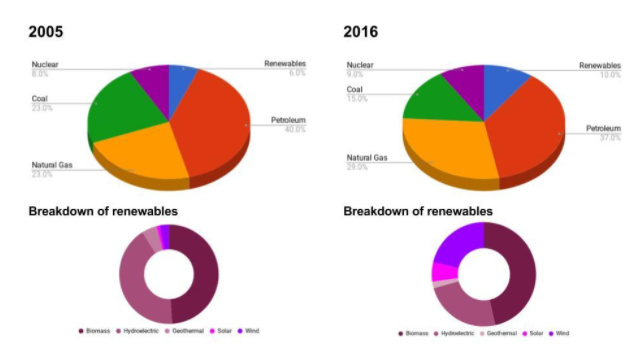By Kyle Pennell
At present, the dominant sources of electricity in the United States are largely fossil fuels. Petroleum, natural gas, and coal continue to make up nearly 85% of energy consumed in this country with nuclear power and renewables like biomass, hydroelectricity, solar, wind and geothermal accounting for the rest.
The times, however, are changing. Advances in technology, driven by demand for cleaner fuels, are producing huge drops in the price of renewable energy sources and batteries. Read on to find out why solar is poised to be the fuel of the future.
The end of coal and the heyday of natural gas
The era of coal is nearing its demise. In the past 10 years alone, coal-derived energy consumption in the US has dropped from 23% to 15% of the market share. The reasons for this are primarily economics-driven. Coal is simply becoming too expensive relative to alternative sources.
For one, the advent of hydraulic fracturing and horizontal drilling has led to a natural gas boom. The US is now the top natural gas producer in the world. At the same time, advances in renewable technologies like wind and solar are beginning to make inroads into the coal market as the threat of global warming and environmental regulations ramp up.
At present, the rise of natural gas is the biggest contributor to coal’s loss of market share. Natural gas’s status as an on-demand resource makes the transition simple. Solar and wind, while offering cleaner energy, continue to face intermittency challenges as their production fluctuates with the sun and wind. But this too is soon to change.

Figure 1. The decline of coal and the rise of solar, wind and natural gas. Source.
Renewables will trump natural gas
Natural gas too, however, will sunset. Natural gas pricing has bottomed out, while that of solar and wind continues to drop. Since 2009, solar photovoltaic (PV) module prices have fallen by 80 percent and wind turbine prices have fallen by around 30-40 percent. Now, a new report suggests a continuation of this trend forecasting a 59% drop in the price of solar and a 35% decline in the price of wind energy by 2025.
The past few years have also seen dramatic advances in lithium ion battery technology with accompanying massive price drops. The price of a lithium ion battery has dropped 70% in the last 18 months as huge producers like LG Chem, Samsung, Panasonic and Tesla ramp up their production capabilities. This trend is predicted to continue over the next several years while battery energy density, or the amount of energy that can be stored, further improves. The availability of affordable large scale battery storage means solar and wind power supplies can be transformed to on-demand resources rendering them competitive with natural gas on all fronts. Research enterprise Bloomberg New Energy Finance declares that batteries capable of storing power at utility scale will be as widespread in 12 years as rooftop solar panels are now and predicts that over the next 25 years, small-scale battery storage will become a $250 billion market.

Figure 2. Battery technology will boost small-scale solar installations. Source.
The renewables revolution will be led by solar, not wind
Both wind and solar power provide viable alternatives to our planet-warming addiction to fossil fuels, but solar offers greater potential for the future. At present, large scale wind installations are slightly cheaper, but the places where windmills can be profitably installed is limited to a small number of high wind areas. Off-shore wind farms have more promise, but are also more expensive to build and maintain. In contrast, the opportunities for solar are boundless due to the possibilities of distribution. You can have large scale solar farms in remote locations, small-scale rooftop generation on buildings and homes, and off-the-grid installations on islands or in emerging economies. As Elon Musk famously stated, “you could take a corner of Utah and Nevada and power the entire United States with solar power.”
As our dependence upon fossil fuels becomes more and more difficult to sustain, both financially and environmentally, it is clear that a practical alternative energy source must be available. While there is a market for a diverse mix of generating sources, from nuclear to natural gas to geothermal, it is becoming increasingly apparent that solar energy coupled with battery storage is the best all-around solution to meet the world’s energy demands. As other sources fall victim to price increases, supply depletion and environmental regulations, the coming energy era promises to be dominated by the sun.


Recent Comments